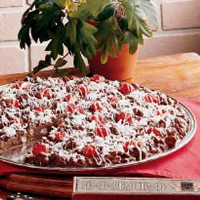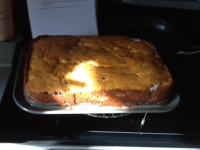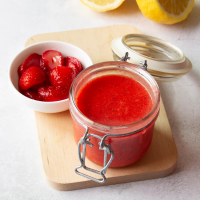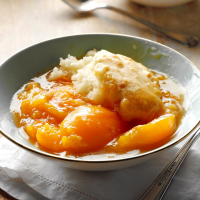SOURDOUGH BREAD | JAMIE OLIVER RECIPES
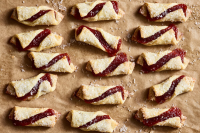
Making your own sourdough takes a bit of prep and know-how, but once you’ve got the knack and start developing your instincts, you’ll be hooked!
Total Time 50 minutes
Yield 1 loaf
Number Of Ingredients 8
Steps:
- The night before you want to bake, make the levain starter. Pour 50ml of tepid water into a large mixing bowl. Use your fingers to gently stir in the mature sourdough starter until fully dissolved, then repeat with the flour until smooth and combined.
- Leave, covered, in a warm place for at least 8 hours – it’s ready when lots of bubbles appear on the surface and the dough has a milky-sweet aroma.
- The next day, to make the final dough, pour 325ml of tepid water into a large mixing bowl and add 100g of the levain, which should float (the remaining levain can be fed and used as a new sourdough starter, or gifted to a friend). Use your fingers to gently stir it into the water until fully dissolved, then repeat with both flours. Cover with a damp cloth and rest in a warm place for 1 hour.
- Now add the salt and 25ml of tepid water, scrunching them into the dough until fully combined. Set aside, covered, in a warm place for 30 minutes.
- Wet your hand slightly and give the dough four folds in the bowl, one at each ‘corner’. This is one turn. Repeat this process another three times at 30-minute intervals, turning the dough four times in total across 2 hours. After the last turn, cover and leave to rise in a warm place for another 2 hours.
- To shape the loaf, tip the dough onto a clean surface and gently dust the top with a handful of semolina flour. Roughly shape into a round, being careful to keep as much air in the dough as possible. Rest, covered, for 30 minutes.
- Dust a basket or cane banneton with semolina flour (or you can simply use a medium bowl lined with a clean, floured tea towel). Lightly flour the dough again and flip it over, so the flour side is on the worktop. Set the dough in front of you and gently shape into a round. Turn the dough over, then place it in your floured basket, banneton or tea towel-lined bowl.
- Cover the dough with a shower cap (or oiled cling film) and allow to rest for 1 to 2 hours, or until increased in size by a quarter and looking bubbly. Transfer your dough, in its basket or bowl, to the fridge to rise for another 12 to 16 hours, or until bubbly and risen by another quarter.
- Place a heavy lidded casserole pot on the bottom shelf of the oven, then preheat to full whack (240ºC/464ºF/gas 9).
- Bring your loaf out of the fridge and scatter semolina over the top. Working carefully, remove the hot pot from the oven, take off the lid and gently tip your dough out into the pot, so now the pattern should be the right way up. Score it with a sharp knife, holding it at a 40 degree angle to the surface of the dough for the best slashes, then carefully cover and return to the oven.
- Reduce the temperature to 230ºC/446ºF/gas 8 and bake for 30 minutes. Carefully remove the lid and bake for a final 20 minutes, or until a malted golden brown. Remove to a wire rack to cool.
Nutrition Facts : Calories 160 calories, FatContent 0.7 g fat, SaturatedFatContent 0.2 g saturated fat, ProteinContent 5.5 g protein, CarbohydrateContent 34.8 g carbohydrate, SugarContent 0.7 g sugar, SodiumContent 0.9 g salt, FiberContent 2.2 g fibre
WHITE SOURDOUGH RECIPE | BBC GOOD FOOD
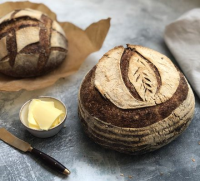
Master the art of making sourdough bread with our step-by-step recipe. Learn how to create a starter, levain and the loaf itself with our expert tips.
Provided by Barney Desmazery
Categories Side dish
Total Time 1 hours 40 minutes
Prep Time 1 hours
Cook Time 40 minutes
Yield Makes 2 loaves (12-15 slices each)
Number Of Ingredients 6
Steps:
- Day 1: To begin your starter, mix 50g flour with 50g tepid water in a jar or, better still, a plastic container. Make sure all the flour is incorporated and leave, semi-uncovered, at room temperature for 24 hrs.
- Day 2: Mix 50g flour with 50g tepid water and stir into yesterday’s mixture. Make sure all the flour is incorporated and leave, semi-uncovered, at room temperature for another 24 hrs.
- Day 3: Mix 50g flour with 50g tepid water and stir into yesterday’s mixture. Make sure all the flour is incorporated and leave, semi-uncovered, at room temperature for another 24 hrs.
- Day 4: You should start to see some activity in the mixture now; there should be some bubbles forming and bubbling on top. Mix 50g flour with 50g tepid water and stir into yesterday’s mixture. Make sure all the flour is incorporated and leave, semi-uncovered, at room temperature for another 24 hrs.
- Day 5: The mixture should be very active now and ready for making your levain. If it’s not bubbling, continue to feed it on a daily basis until it does. When it’s ready, it should smell like yogurt.
- You now have a starter, which is the base to the bread. You’ll need to look after it, but naming is optional! Keep it in the fridge (it will stay dormant) and 24 hrs before you want to use it, pour half of it off and feed it with 100g flour and 100g water. Leave it at room temperature and it should become active again. The longer the starter has been dormant, the more times it will need to be refreshed – the process of pouring off half the starter and replacing it with new flour and water – to reactivate. If your starter is ready to use, a teaspoonful of the mixture should float in warm water.
- For the levain Mix 1 tbsp of the starter with 100g flour and 100g water (this is the same process as feeding the starter, but you should do this in a new, separate bowl, keeping the original starter as back-up, as this is the mixture you'll use to bake your bread). Leave the levain for 8 hrs at room temperature until it becomes active. When ready, a teaspoonful of the mixture should float in warm water.
- For the bread Pour 600g tepid water into the levain and stir with a rubber spatula to mix together – don’t worry if there are unmixed bits of levain. Tip in the flour and mix everything together with a rubber spatula to make a rough dough, ensuring all the flour is incorporated evenly and that there are no dry bits up the side of the bowl. Cover and leave somewhere warm for at least 30 mins, or up to 4 hrs.
- Sprinkle over the salt and add 50g water to the dough. Pinch and scrunch the salt and water through the dough with your hands. If the dough goes stringy (like old chewing gum), just keep working it until it’s one smooth texture. Leave for another 15 mins.
- Wet your hands, grab the dough from one side and stretch it over itself, then repeat with the other side. This stretching technique helps develop the gluten. Pick the dough up and curl it around onto itself, then cover and leave for another 20-30 mins. Repeat this process two more times (three in total), then leave the dough for another 2-3 hrs until it’s risen by about 30% and looks bubbly and soft.
- Using a rubber spatula, scrape the dough out onto a lightly floured work surface and split in two. Fold each piece onto itself to create a ball, then leave uncovered for 30 mins. The dough balls will spread during this time.
- Dust two bread-proving baskets generously with flour. Scrape one of the balls of dough off the work surface, then fold it onto itself to create a tight ball that’s trapped in all the air. Lift the ball into a basket, seam-side up, then transfer to the fridge to chill overnight, or for up to 18 hrs. Repeat with the other dough ball.
- Heat the oven to 240C/220C fan/gas 9 and put a lidded casserole dish in the oven to heat. Cut a sheet of baking parchment into a square slightly larger than the base of one of the loaves. Carefully remove the hot casserole dish from the oven and remove the lid. Invert one loaf onto the baking parchment, then, working quickly, score the top at an angle. Use the corners of the parchment to lift the loaf into the casserole dish. Cover with the lid and bake for 30 mins, then carefully uncover and continue to bake for another 10 mins (or longer for a darker finish). Carefully lift the bread out of the dish using a spatula, transfer to a wire rack and leave to cool to room temperature before slicing. Repeat with the second loaf.
Nutrition Facts : Calories 171 calories, FatContent 1 grams fat, SaturatedFatContent 0.1 grams saturated fat, CarbohydrateContent 35 grams carbohydrates, SugarContent 0.2 grams sugar, FiberContent 1 grams fiber, ProteinContent 6 grams protein, SodiumContent 0.8 milligram of sodium
More about "sourdough bowl recipes"
EASY SOURDOUGH BREAD RECIPE | BBC GOOD FOOD
From bbcgoodfood.com
Total Time 1 hours
Category Buffet, Side dish, Snack
Cuisine British
Calories 172 calories per serving
- Heat oven to 220C/200C fan/gas 7. Place a sturdy flat baking tray on the middle shelf of the oven and a smaller tray with sides underneath. Dust the dough with flour and slash with a utility knife. Slide the bread onto the hot tray on top and throw a few ice cubes (or pour some cold water) onto the tray below – this creates a burst of steam, which helps the bread form a nice crust. Bake for 25-30 mins until the loaf sounds hollow when tapped on the bottom. Leave the bread to cool completely.
HOW TO MAKE A SOURDOUGH STARTER | SOURDOUGH | RECIPES ...
From dovesfarm.co.uk
Reviews 5
- Starter – use this handy chart to help you keep track of your feeding times. On the first day, put one tablespoon of flour and one of water into a 500ml glass bowl and mix together. Wet a clean tea towel, wring it out well, lay it over the bowl and leave in a warm place for about 12 hours. After the 12 hours have passed, add another tablespoon of flour and another of water, mix together, cover with the damp tea towel and leave for another 12 hours. On day two (24 hours since beginning your starter), stir in a third tablespoon of flour and a third spoon of water, stir to mix, cover again with the damp tea towel and leave in a warm place for 12 hours. For the second feed of day two, add a tablespoon of flour and one of water, stir to mix, cover with the damp tea towel and leave in a warm place for 12 hours. For the first feed of day three (36 hours since beginning your starter), increase the feed by adding two tablespoons of flour and two of water, stir to mix. Re-dampen the tea towel if necessary, lay it over the bowl and leave in a warm place for 12 hours. On the second feed of day three, add two tablespoon of flour and another two of water, mix together, cover and leave for another 12 hours. At this point your starter should be bubbly and ready to create your ferment. If the starter is not showing bubbles, repeat the 12-hour flour and water feeding routine, and ensure the starter is kept constantly in a warm place. Click this link to find a handy Sourdough Starter Chart which when printed has space for you to enter the day and time that you feed your starter with flour and water and to help monitor progress. This Guide to Sourdough Making contains lots of hints and tips for successful sourdough bread making.
RYE SOURDOUGH BREAD RECIPE | BBC GOOD FOOD
From bbcgoodfood.com
Category Buffet, Side dish
Calories 180 calories per serving
- Heat the oven to 230/210C fan/gas 8 with a shelf in the middle of the oven and a shelf below with a roasting tray on it. Put the loaf on the middle tray and carefully pour a small glass of water into the roasting tray. Cook for 50-55 mins until hollow sounding when tapped. (The middle of the loaf will read 98C on a digital thermometer when ready.) Remove the tin and leave to cool on a wire rack for at least 4 hrs. Will keep for 3-4 days in an airtight container.
RYE SOURDOUGH BREAD RECIPE | BBC GOOD FOOD
From bbcgoodfood.com
Category Buffet, Side dish
Calories 180 calories per serving
- Heat the oven to 230/210C fan/gas 8 with a shelf in the middle of the oven and a shelf below with a roasting tray on it. Put the loaf on the middle tray and carefully pour a small glass of water into the roasting tray. Cook for 50-55 mins until hollow sounding when tapped. (The middle of the loaf will read 98C on a digital thermometer when ready.) Remove the tin and leave to cool on a wire rack for at least 4 hrs. Will keep for 3-4 days in an airtight container.
MY TOP 3 LEFTOVER SOURDOUGH STARTER RECIPES | THE PERFECT LOAF
From theperfectloaf.com
SOURDOUGH STARTER RECIPE | ALLRECIPES
From allrecipes.com
36 RECIPES THAT START WITH SOURDOUGH BREAD | TASTE OF HOME
From tasteofhome.com
LEFTOVER SOURDOUGH STARTER RECIPES: THE ULTIMATE LIST ...
From loveremodeled.com
SOURDOUGH DISCARD 101: RECIPES & FAQS ANSWERED - THE ...
From theclevercarrot.com
EXTRA-TANGY SOURDOUGH BREAD | KING ARTHUR BAKING
From kingarthurbaking.com
SOURDOUGH RYE RECIPE | ALLRECIPES
From allrecipes.com
BOWL RECIPES | ALLRECIPES
From allrecipes.com
POTATO SOURDOUGH BREAD STARTER RECIPE - THE SPRUCE EATS
From thespruceeats.com
SOURDOUGH RYE RECIPE | ALLRECIPES
From allrecipes.com
BOWL RECIPES | ALLRECIPES
From allrecipes.com
POTATO SOURDOUGH BREAD STARTER RECIPE - THE SPRUCE EATS
From thespruceeats.com















